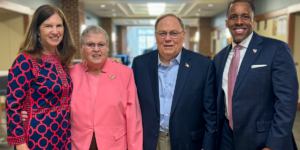The Friday Faculty Spotlight, designed to help the entire university community to get to know our faculty members, has returned for 2023! This week, the spotlight is on College of Arts and Sciences Assistant Dean and Director of Innovation and Assistant Professor of Environmental Studies and Biology Allyson Degrassi, Ph.D.
In this Q&A, you’ll find out why Dr. Degrassi decided Shenandoah was the place for her, the path to being an educator that she never foresaw, the environment she thrives in, and a fun fact or two!
When did you join Shenandoah, and what appealed to you about the university?
I joined the Shenandoah University family as an assistant professor of environmental studies and biology in Fall 2019. The job description seemed like it was written for me! The environmental studies and biology departments were looking for someone to teach both environmental science and ecology and I consider myself an environmental field ecologist! I enjoyed meeting the students, the faculty on the search committee, and administration during my interview. I could not believe that I was having FUN at a job interview! That affinity and the need to be in this area for my family was everything that I hoped for. It really felt like the stars aligned perfectly (SU stars pun intended).
What inspired you to become an educator?
I never thought I would become an educator. I worked in many different types of jobs from curtain inspector to “eyeball nurse” and teaching and research never crossed my mind. When I started at California State University, Fullerton, as an undergraduate, I was accepted into a National Science Foundation-funded program that supported undergraduates with research and a faculty mentor in environmental biology. My mentor, Dr. Bill Hoese, asked me to become a student instructor for his biology courses. I developed and led supplemental lectures to the biology courses for students needing a little more help with course material. I was apprehensive at first, but my lectures would fill up with 30+ students every week and we really dove headfirst into the material! It was exciting to see that I was helping people understand a subject that I absolutely loved. That excitement of learning and teaching grew when I became a teaching assistant (TA) in graduate school at the University of Vermont (UVM). I loved teaching labs where students were able to have hands-on experience in their learning. To be honest, I still was not thinking that I would become a professor. Entering an agreement to be partly responsible for another person’s education is intimidating and I was not sure if I was an effective educator. However, after I received Teaching Assistant of the Year after one year of being a TA, I decided that I would also enroll in UVM’s Graduate Teaching in Higher Education program, where I could learn how to teach effectively. I fell in love with teaching as much as I loved conducting research and that only left one path open to me! I needed to become a professor at a primarily undergraduate institution. I can’t picture myself doing anything else.
You’re assistant dean of innovation for the College of Arts & Sciences, and assistant professor of environmental studies and biology. What does it mean to be director of innovation?
I was very happy to accept the position for assistant dean of academic innovation for the College of Arts and Sciences (CAS) mainly because it ties together what I love about academia – learning, creating, and doing! Universities are supposed to be places where thought springs to life, where flames of ideas are fueled.
In this position, I have the opportunity to help foster the creation and development of new academic programs and pathways, to explore revisions of current programs and pathways, and to offer support for faculty in carrying out such initiatives. In short, I get to work more closely with my colleagues to create unique programs that will help our CAS learners foster what they love and learn how to use it to be happy and successful, and to contribute to making a better world for all.
How do you balance all your work responsibilities?
I do struggle with a healthy work-life balance, but I am getting better! I love spending quality time with my family, but I also love teaching, conducting research, mentoring students one-on-one, and learning. I don’t want to miss out on any of it, so I often work very weird hours and sometimes unhealthy hours. I would get up early and help get my son ready for school in the morning before I would teach back-to-back classes during the day. When I would get home, I would spend all evening with my family until they went to bed. Once they were asleep, I would stay up late (or early the next morning) preparing for classes. In my experience, it was more difficult to balance family and work the first four years. In the early years, developing classes with meaningful and rigorous experiences for the students takes a lot of time. But, the time required for course development decreases after you have taught it a couple of times, so the super-late nights do not happen often!
I am also lucky because I have made some friends at SU who really supported me and taught me how to navigate SU – they know who they are! I could ask them any question at any time and they would help me. I am still learning and they are STILL helping me. There are several whom I consider unofficial mentors and I know that I would not have been able to keep balanced without their support. I am truly grateful to be at a place where the faculty care for their colleagues as well as their students.
What are your areas of research and why have you decided to study them?
I primarily research environmental impacts on wildlife populations and behavior. I have conducted research in marine, forest, and desert environments and I have studied snails, crabs, fish, rodents, salamanders, turtles, and bats! I can’t really tell you why I decided to study them. I usually hear or read some cool facts about an animal, then I want to discover something for myself. This year, I am going to start studying the relationship among below-ground mycorrhizal fungi, above-ground pollinator behaviors, and human agricultural practices, just because it sounds like fun!
Your nominator said it’s always a joy to come to your class. What is your teaching philosophy, and how do you keep yourself and your students inspired?
I want my students to want to come to class, not just because the content is amazing, but because they feel like it is their class too. In most of my classes, I try to provide my students with options for assignments, how they choose to present their work, and what topics they want to work on under the umbrella of the course topic. I want them to share the responsibility of learning. In one upper-division class, I have students co-design and co-teach the material with me! It is so much fun to see their level of involvement and engagement change.
What do you hope your students will take with them from their time working with you?
I hope that my students will be confident in what they know and comfortable with knowing they don’t know everything! I want them to love to learn, and not just in a college setting. I want them to be independent and be empowered in their learning. I am very comfortable and honest with my students about what I know and what I don’t know, but I teach them how to learn and reason things out. I hope they take the love of asking questions and discovering answers with them.
How do you spend your free time?
When I am not working, I am spending time with my family and enjoying being with my son! He is the best person I know.
What’s a little-known fact about you?
I have lived in a lot of different places and when I talk, my accents and regional phrases blend together, so it’s not always easy for people to guess where I am from, because I am really not from any one place!
If there’s a faculty member you feel the university community needs to get to know better, just fill out the Friday Faculty Spotlight submission form. If you have any questions, please contact omc@su.edu.




